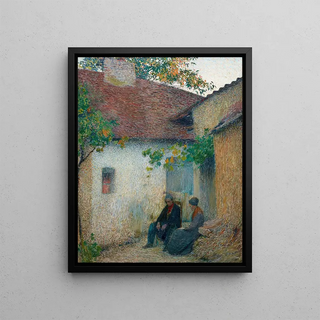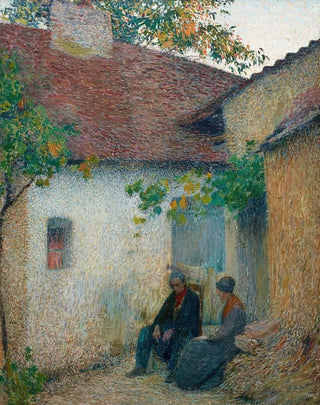Art print | Couple in conversation in front of the farm - Henri Martin


View from behind

Frame (optional)
In the vast universe of art, some works manage to capture the very essence of everyday life while revealing an unexpected emotional depth. "Couple in conversation in front of the farm" by Henri Martin is one of these creations. Painted at the end of the 19th century, this canvas invites the viewer to immerse themselves in a moment of shared complicity, where the dialogue between the characters seems to transcend time. The scene, both simple and evocative, depicts a palpable intimacy, a frozen moment where exchanged glances reveal much about the feelings uniting the protagonists. The soft light bathing the composition and the shimmering colors transport the viewer to a space where nature and humanity coexist harmoniously.
Style and uniqueness of the work
Henri Martin, master of pointillism, manages to infuse a unique dynamism into his works. In "Couple in conversation in front of the farm," he uses vibrant color strokes to create a warm and welcoming atmosphere. The characters, although stylized, exude an authenticity that makes them accessible and endearing. The technique of pointillism, which involves juxtaposing dots of color, allows the light to play a central role in the composition, thus enhancing the sensation of movement and life. Shades of green and yellow blend harmoniously, evoking the surrounding fields and the serene beauty of the French countryside. This work stands out for its ability to evoke simple yet profound emotions, such as tenderness, complicity, and harmony with nature.
The artist and his influence
Henri Martin, born in 1860, is an emblematic figure of the post-impressionist movement. Influenced by masters such as Georges Seurat and Paul Signac, he developed a style that is uniquely his own, combining the rigor of pointillism with romantic sensitivity. His work reflects a deep attachment to nature and rural life, recurring themes throughout his career. Martin was also a fervent advocate of plein air art, seeking to capture the changing light and colors of the landscapes he painted. His influence extends

Matte finish

View from behind

Frame (optional)
In the vast universe of art, some works manage to capture the very essence of everyday life while revealing an unexpected emotional depth. "Couple in conversation in front of the farm" by Henri Martin is one of these creations. Painted at the end of the 19th century, this canvas invites the viewer to immerse themselves in a moment of shared complicity, where the dialogue between the characters seems to transcend time. The scene, both simple and evocative, depicts a palpable intimacy, a frozen moment where exchanged glances reveal much about the feelings uniting the protagonists. The soft light bathing the composition and the shimmering colors transport the viewer to a space where nature and humanity coexist harmoniously.
Style and uniqueness of the work
Henri Martin, master of pointillism, manages to infuse a unique dynamism into his works. In "Couple in conversation in front of the farm," he uses vibrant color strokes to create a warm and welcoming atmosphere. The characters, although stylized, exude an authenticity that makes them accessible and endearing. The technique of pointillism, which involves juxtaposing dots of color, allows the light to play a central role in the composition, thus enhancing the sensation of movement and life. Shades of green and yellow blend harmoniously, evoking the surrounding fields and the serene beauty of the French countryside. This work stands out for its ability to evoke simple yet profound emotions, such as tenderness, complicity, and harmony with nature.
The artist and his influence
Henri Martin, born in 1860, is an emblematic figure of the post-impressionist movement. Influenced by masters such as Georges Seurat and Paul Signac, he developed a style that is uniquely his own, combining the rigor of pointillism with romantic sensitivity. His work reflects a deep attachment to nature and rural life, recurring themes throughout his career. Martin was also a fervent advocate of plein air art, seeking to capture the changing light and colors of the landscapes he painted. His influence extends






